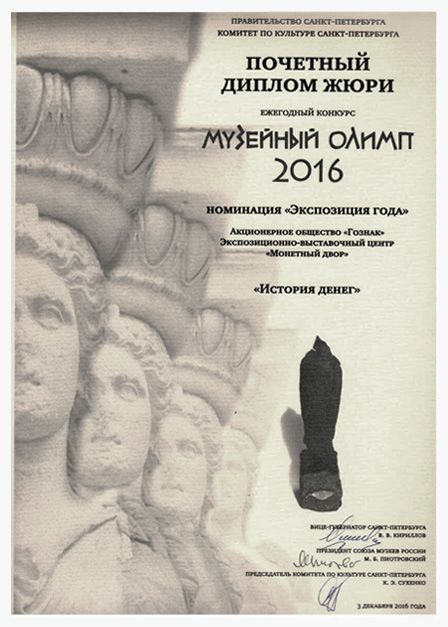Concept
A.A. Bogdanov
Museum of History of Money, located in the center of St. Petersburg, in the historic building of the Anninsky Cavalier of the Peter and Paul Fortress, was created on the initiative of JSC Goznak, an affiliate of Russian Ministry of Finance. The basis for the exhibition is the extensive collection of the special fund of Goznak, holding more than 2,500 coins and banknotes. Among the authentic museum items a visitor can also find some unique historical reconstructions made by the KMVI team.
A number of showcases is organized as thematic staged scenes or layouts. According to the artistic concept, each historical section of the museum is a demonstration of various technological stages of making money. The scenes are presented in great detail and in a visually clear manner, with the help of multimedia, installations and recreated objects. The multimedia systems installed help solve tricky tasks like demonstrating exhibits from all angles, enlarging them to study in detail, providing additional language support as well as giving detailed annotations and adding video content.
When the museum equipment was designed and installed, important factors were taken into account, such as protecting the items from external influence, exhibiting watermarked materials and items of specific shape and size. All the above-mentioned influenced the look and contents of the exhibition modules, where special attention was paid to the typology of elements, the clear concise image and conscious use of decoration and artistic styling. All those techniques were used to make the Museum of History of Money more exciting, interactive and attractive for visitors of various age and language groups

While mounting the permanent exhibition, the KMVI team also designed and decorated the museum interior. Part of the new image were the decorative metal pylons framing the load-bearing columns of the building. The main concept was to imitate an appearance and ambience of old bank vaults. Made of metal with decorative deep etching and engraving, the pylons imitate large vaults with rich brass details. Showcases, decorative and interactive modules are integrated into the pylon panels, imitating elements of strongroom doors and mechanisms

The monumental artistic installations, also the product of KMVI creative group, proved to be showstoppers. One of those is the installation "Million": precisely one million of one-ruble coins collected in 350 columns of different size. They get as high as 5 meters, and the weight of the installation is 1.5 tons. Next to the tower of coins, there is a set of showcases with modern bank cards, demonstrating the difference between the concept of physical and digital amounts of money
Художественные
и технические решения

Two exceptionally detailed and artistic layouts were created for the exhibition by the KMVI team to illustrate some of the old technology in miniature. The themes are “Coin production in the 18th century” and “Paper production in the 18th century”. It took great skill and a lot of work to think through the control system for the moving elements of the layout, their sequence and interaction. The realistic details and textures make it an art object as well an educational instrument. All automatons perform a sequence of procedures imitating a production process in accordance with the scenario, and give a complete picture of the technologies and crafts of that time. The movement of the layouts is launched by the visitor using the showcase information pad

A wide range of historical documents and artefacts was recreated for the new museum exhibition. Authentic natural materials and original technologies were used in the process. Detailed recreations of birch-bark letters and a series of engravings in various formats are particularly noteworthy. To manufacture some exhibits, the craftsmen used original samples of historical paper of the 19th century with watermarks

To demonstrate the working principles of some historical machines used in the production of coins, the KMVI team built several life-size kinetic models, including an 18th-century desktop screw press and a kinetic mock-up of a headstock machine from the first half of the 18th century. Layouts have an automatic launch interval but can also be activated using the showcase information pad. The machines were copied with maximum accuracy having used the real prototypes

Another part of the KMVI job according to the project was selection and purchase of some archaeological artefacts for the museum funds, as well as reconstructing some of the pieces for the exhibition. Also, several ethnic and ritual costumes were made in collaboration with the Russian Ethnographic Museum, to illustrate the use of coins in clothing and household items adorning
Execution of counterfeiters. Miniature
from the Front Chronicle
(1560-1570s)
